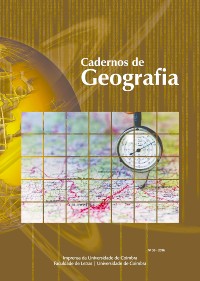Please use this identifier to cite or link to this item:
https://hdl.handle.net/10316.2/40770| Title: | Sistema viário e dinâmicas produtivas pioneiras na porção leste da Amazônia setentrional brasileira | Other Titles: | Transport system and pioneering production dynamics in the eastern portion of the northern brazilian Amazon | Authors: | Silva, Olavo Fagundes da Cunha, Lúcio |
Keywords: | Amapá;Pioneering dynamics;Extraction;Transport system;Amapá;Dinâmicas pioneiras;Extrativismo;Sistema viário | Issue Date: | 2016 | Publisher: | Imprensa da Universidade de Coimbra | Abstract: | Na Amazônia setentrional brasileira as grandes distâncias a ser em percorridas e a bar reira natural imposta
pelo Rio Amazonas, constituiram uma grande dificuldade para a atuação do Estado Nacional brasileiro até ao
fim da primeira metade do século XX. Na sua porção leste, apesar da incipiência do Estado, as dinâmicas de
desenvolvimento regional baseadas no extrativismo florestal permitiram manter relativa soberania sobre o território
que também era reclamado pelos franceses. Logo após a descoberta das jazidas de manganês em Serra
do Navio, no início da década de 1940, o Brasil consolidou sua soberania através da criação do Território Federal
do Amapá e da dotação de uma estrutura administrativa que pegou embalo na infraestrutura para exploração
mineral implantada pela inciativa privada do capital nacional associado ao internacional. Observando esse período
histórico, tentou-se, com base na avaliação das estruturas fixadas no espaço, efetuar um estudo que pudesse
indicar como o sistema viário evoluiu nesta região do país e qual sua relação com as dinâmicas pioneiras
de desenvolvimento regional. Constatou-se que o sistema viário no Amapá apresentava uma relação direta com
as dinâmicas extrativistas e que a sua evolução em grande medida se deveu à expansão ou retração gradativa
do processo produtivo nessas atividades. In the northern Brazilian Amazon the large distances to be covered and natural barrier by the Amazon River, imposed great difficulty to the performance of the Brazilian National State until the end of the first half of the twentieth century. In the eastern portion, despite the insipience of state, dynamics of regional development based on forest extraction helped maintain relative sovereignty over the territory which was also contested by the French. After the discovery of manganese deposits in Serra do Navio in the early 1940s, Brazil consolidated its sovereignty through the creation of the Federal Territory of Amapá and the provision of an administrative structure that took momentum in infrastructure for mineral exploration implemented by initiative private national capital associate to international. Noting that historical period, an attempt was made based on the evaluation of the structures established in the space make a study that could indicate how the road system evolved in this region of the country and what their relationship to dynamic pioneer of regional development. It was found that the transport system in Amapá had a directly proportional relation to the extractive dynamics and their evolution largely due to the expansion or gradual decrease of the production process in these activities. |
URI: | https://hdl.handle.net/10316.2/40770 | ISSN: | 0871-1623 2183-4016 (digital) |
DOI: | 10.14195/0871-1623_35_1 | Rights: | open access |
| Appears in Collections: | Cadernos de Geografia |
Files in This Item:
| File | Description | Size | Format | |
|---|---|---|---|---|
| sistema_viario_e_dinamicas_produtivas_pioneiras_na_porcao_leste_da_amazonia.pdf | 2.08 MB | Adobe PDF |  |
Items in DSpace are protected by copyright, with all rights reserved, unless otherwise indicated.
